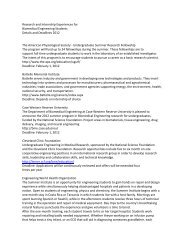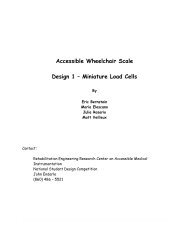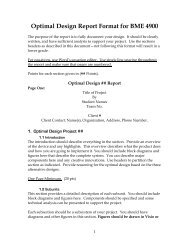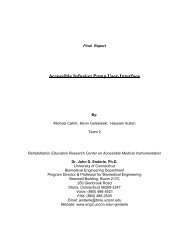BME 4900 Final Report - Biomedical Engineering - University of ...
BME 4900 Final Report - Biomedical Engineering - University of ...
BME 4900 Final Report - Biomedical Engineering - University of ...
Create successful ePaper yourself
Turn your PDF publications into a flip-book with our unique Google optimized e-Paper software.
3 Realistic Constraints<strong>BME</strong> <strong>4900</strong> FINAL REPORT 25Team 8Due to the size and application <strong>of</strong> this neural network, there are no organizationsthat must approve the manner in which the project is performed. The circuit is not to beimplanted in an individual, and therefore does not need to be approved by the FDA. Thefinal product will also not be <strong>of</strong> such a size that structural or mechanical issues pose aserious concern, and require no certification in that regard. The constraints on theproject are subtle, but do limit its functionality in some aspects.The design <strong>of</strong> the circuit model is such that it represents the major populations <strong>of</strong>neurons involved in producing the signals for the lateral and medial rectus models,yielding a certain degree <strong>of</strong> physiological realism. The resulting signals do resemble theactual action potential with regards to their firing rates, though the amplitudesimmediately produced are not as accurate. The functionality <strong>of</strong> the circuit has beengiven priority <strong>of</strong> the physiological realism <strong>of</strong> the amplitude. The measurable signals canbe dampened in order to yield more appropriate amplitudes, but the fact still remainsthat the circuits, on their own, do not yield the expected physiological voltages.The circuits for the individual neuron populations are designed such that theycannot be altered once connected to the printed circuit board. This property means thatif additional information becomes available that would suggest altering the behavior <strong>of</strong>neuron, the circuit board is more likely to need to be completely replaced. However, thisdesign choice gives more reliable, durable neuron circuits. Allowing for interchangeableparts would result in the inability to solder components into place, greatly increasing thepossibility <strong>of</strong> parts becoming loose during handling, causing the entire neural network toyield inaccurate signals.Beyond these implementation constraints, the device does not create any sort <strong>of</strong>controversy with regards to its production. Of all the proposed designs, this methodinvolved the least quantity <strong>of</strong> parts, ultimately yielding the least expensive model. This
















